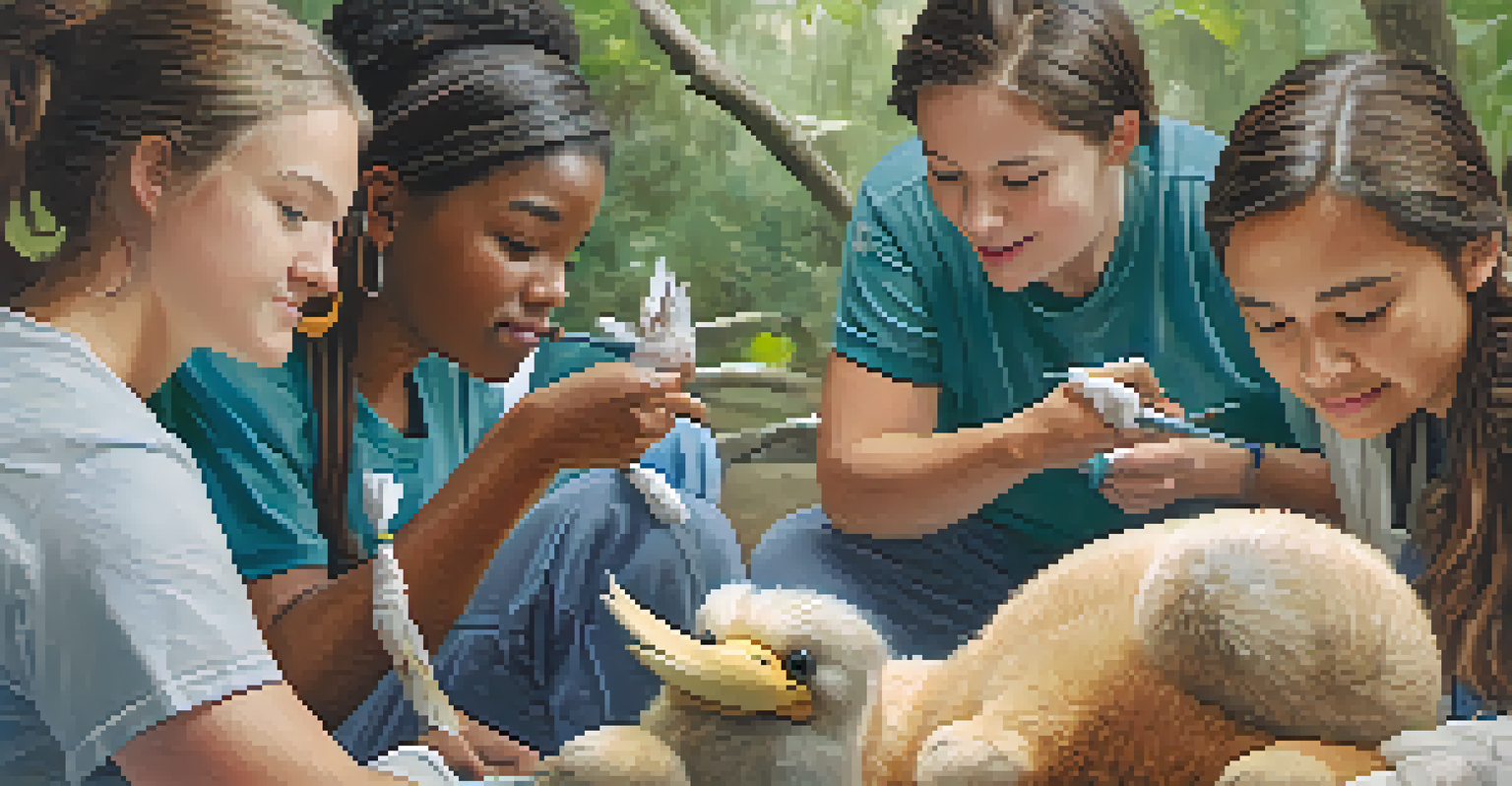Understanding Arizona's Wildlife Rehabilitation Laws and Policies

Introduction to Wildlife Rehabilitation in Arizona
Wildlife rehabilitation is the process of caring for injured, sick, or orphaned wild animals with the aim of returning them to their natural habitat. In Arizona, this practice is guided by specific laws and policies that ensure the safety of both animals and humans. Understanding these regulations is crucial for anyone interested in helping wildlife in the state.
The greatness of a nation and its moral progress can be judged by the way its animals are treated.
The Arizona Game and Fish Department (AZGFD) oversees wildlife rehabilitation, establishing guidelines that rehabilitators must follow. These rules are designed to maintain the welfare of wildlife while also protecting ecosystems. By adhering to these regulations, rehabilitators can provide effective care for animals in need.
For those considering becoming wildlife rehabilitators, it’s essential to familiarize yourself with Arizona’s specific laws. This knowledge not only helps in legal compliance but also enhances the effectiveness of rehabilitation efforts, ensuring a successful return to the wild.
Key Laws Governing Wildlife Rehabilitation
In Arizona, the core laws related to wildlife rehabilitation are outlined in the Arizona Revised Statutes (ARS) and the Arizona Administrative Code (AAC). These laws specify who can rehabilitate wildlife and under what conditions. Notably, a state-issued permit is required for any individual wishing to rehabilitate wildlife legally.

The AZGFD establishes different categories of permits based on the species being rehabilitated, reflecting the diverse wildlife present in Arizona. For instance, certain permits are tailored for small mammals, birds, and reptiles, each with its own set of requirements. Understanding these distinctions is crucial for prospective rehabilitators.
Understanding Rehabilitation Laws
Familiarity with Arizona's wildlife rehabilitation laws is essential for legal compliance and effective animal care.
Moreover, the laws mandate that rehabilitators must demonstrate knowledge in animal care, species identification, and relevant veterinary practices. This ensures that all individuals engaged in wildlife rehabilitation are adequately prepared to provide the necessary care.
Becoming a Licensed Wildlife Rehabilitator
To become a licensed wildlife rehabilitator in Arizona, one must complete a series of steps, starting with obtaining a permit from the AZGFD. The application process involves demonstrating experience and knowledge in animal care, which can often be gained through volunteer work at established rehabilitation centers. This hands-on experience is invaluable.
Wildlife conservation is the preservation of the world's wildlife and its habitats for future generations.
After receiving a permit, rehabilitators must adhere to ongoing training requirements to stay updated on best practices and changes in laws. This could include attending workshops, seminars, or taking relevant courses. Continuous learning helps improve rehabilitation techniques and animal care standards.
Additionally, some rehabilitators may choose to specialize in certain species or types of care, such as birds of prey or small mammals. Specialization can enhance the effectiveness of rehabilitation efforts and contribute to the overall success of wildlife conservation in Arizona.
Common Challenges in Wildlife Rehabilitation
Wildlife rehabilitation is not without its challenges. One of the most significant hurdles is the limited resources available to many rehabilitators, including funding and access to veterinary care. This scarcity can impact the quality of care that rehabilitators can provide to injured or orphaned wildlife.
Another challenge is the emotional toll of the work. Rehabilitators often face difficult decisions regarding the fate of animals, especially when dealing with severe injuries or illnesses. Balancing compassion for the animals with the reality of their situations can be particularly taxing.
Challenges Wildlife Rehabilitators Face
Rehabilitators encounter challenges such as limited resources and emotional decisions regarding animal care.
Moreover, rehabilitators must navigate public misconceptions about wildlife and their care. Educating the community about the importance of wildlife conservation and the role of rehabilitators is essential in fostering support and understanding for these efforts.
The Role of the Arizona Game and Fish Department
The Arizona Game and Fish Department plays a crucial role in overseeing wildlife rehabilitation efforts across the state. They not only issue permits but also provide guidance and support to rehabilitators. This partnership helps ensure that wildlife rehabilitation is conducted in a manner that is both humane and effective.
AZGFD also conducts regular inspections of rehabilitation facilities to ensure compliance with state laws and standards. These inspections help maintain a high level of care for wildlife, addressing any issues that may arise. By working closely with rehabilitators, the department fosters a collaborative approach to wildlife conservation.
Furthermore, the AZGFD engages in community outreach initiatives to raise awareness about wildlife issues and the importance of rehabilitation. By educating the public, they encourage responsible behavior towards wildlife and support for rehabilitation efforts.
Wildlife Rehabilitation Best Practices
Adhering to best practices in wildlife rehabilitation is essential for the health and safety of both animals and rehabilitators. Key practices include providing a clean and safe environment, offering appropriate food and care tailored to the species, and minimizing human interaction to reduce stress. Each of these aspects plays a vital role in successful rehabilitation.
Additionally, proper record-keeping is critical. Rehabilitators should document the health and progress of each animal, including treatments administered and behavioral observations. This information not only aids in individual care but also contributes to overall data collection in wildlife rehabilitation.
Importance of Best Practices
Adhering to best practices in wildlife rehabilitation ensures the health and safety of both animals and rehabilitators.
Finally, networking with other rehabilitators and wildlife professionals can enhance best practices. Sharing insights and experiences can lead to improved techniques and a more effective rehabilitation process, ultimately benefiting the wildlife community in Arizona.
Conclusion: The Importance of Wildlife Rehabilitation
Wildlife rehabilitation is a vital component of wildlife conservation in Arizona and across the globe. It not only helps individual animals recover but also contributes to the health of ecosystems. By understanding and following Arizona’s laws and policies, rehabilitators can play an essential role in preserving wildlife.
Moreover, the work of rehabilitators often serves to educate the public about the importance of wildlife conservation. As communities become more aware of these issues, support for rehabilitation efforts grows, creating a positive cycle of awareness and action.

Ultimately, understanding Arizona's wildlife rehabilitation laws is more than just a legal obligation—it's a commitment to protecting the incredible diversity of wildlife that inhabits our state.